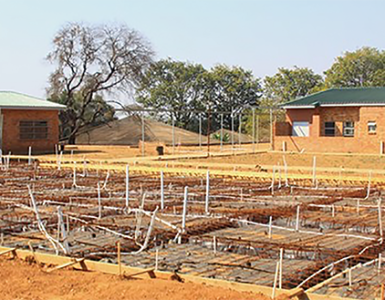BURDEN: Child marriages root of the problem as an under-18 girl is forced into marriage every 30 seconds in war zones…
By Monk Nkomo
Nearly 21million girls – between ages 15 and 19 – fell pregnant in developing countries annually in the past decade, endangering their lives and futures.

A World Health Organization Report, released yesterday, has warned that child marriage was a global crisis and the primary driver behind early pregnancies especially war zones.
To compound matters, one in every five young women worldwide, got married before their 18th birthday with the levels highest in sub-Saharan Africa. The situation was most dire in fragile states where Save the Children, a leading humanitarian organisation, reported last year that a girl got married every 30 seconds. Nearly 650 million women alive today were married as children, with one in 20 worldwide, wed before the age of 15.
An estimated 12 million girls were married before the age of 18 annually – approximately one in every three seconds, according to Girls Not Brides , a coalition of over 14 000 international and human rights organization. In low and middle-income countries, nine out of ten adolescent births occurred among girls married before the age of 18.
These shocking revelations are contained in the World Health Organization’s first update in 13 years to guidelines aimed at preventing adolescent pregnancies.
The document, published recently by the UN health agency pinpoints uptake and access to safe contraception, barriers to girls’ right to education, child marriage laws and access to sexual and reproductive health services broadly as fundamental to reducing early pregnancies which endangered adolescents around the world.
“Early pregnancies can have serious physical and psychological consequences for girls and young women and often reflect fundamental inequalities that affect their ability to shape their relationships and their lives,” said Dr Pascale Allotey, Director of Sexual and Reproductive Health and Research at WHO.
‘’The global crisis affects millions of girls, with devastating health consequences rippling across generations, particularly in regions torn by conflict and instability. Pregnancy and childbirth complications rank among the leading killers of girls aged 15-19 worldwide.’’
Over 21 million girls between 15 and 19 became pregnant annually in low and middle-income countries, the WHO review found. Half of those pregnancies were unintended, while 55 percent led to abortions—often performed in unsafe conditions, carrying life-threatening risks. In many settings, girls also chose to become pregnant because they had limited educational and employment prospects. Some adolescents did not desire to use contraception because of fear of side effects and because they mistakenly believed it could prevent them from getting pregnant in the future.
‘’ They believe its use conflicts with their traditional and religious directives. In this context, information and education on contraception are required, including efforts to understand and address myths and misconceptions.’’
In South Africa, a total 91 000 children of school-going age were married in 2018. At least 122 girls between the ages of 12 and 17 went through divorce in Kwa- Zulu Natal in 2017 – a province which has been identified as having the highest number of forced marriages and the harmful traditional practice known as ukuthwala. This practice was prevalent in the Eastern Cape, KZN and Western Cape.
In many cases, some money or gifts were given to parents in a distortion of traditional dowry ( lobola) practices. According to Masiphephe, a network of over 200 community and gender-based violence prevention and response partners across Gauteng, KZN and Mpumalanga, four percent of girls in South Africa were married before the age of 18 and one percent of both girls and boys were married before their 15th birthday.
The existing legislation in South Africa made provision for the marriage of minors provided that the legally required consent had been granted and submitted to the Marriage Officer in writing. Under the Children’s Act 38 of 2005, the minimum legal age of marriage is 18 years for girls and boys. ‘’However inconsistences and loopholes exist throughout the legislation.’’
Maternal conditions were among the top causes of disability-affected life years and mortality globally, according to the United Nations Children’s Fund (UNICEF).
Health dangers from pregnancy were intensified for mothers aged 10-19, who faced significantly higher risks than women in their twenties, including dangerous high blood pressure conditions like eclampsia, post-childbirth uterine infections and systemic infections.
According to the WHO review, the health consequences extended to their infants as well. Babies born to adolescent mothers had higher rates of low birth weight, premature birth and serious neonatal conditions compared to those born to older mothers.
“Adolescents who give birth face higher risks of maternal and infant mortality compared with older women, while early pregnancies can restrict adolescents’ choices, limiting their educational and economic prospects,” Allotey said. “These limitations often perpetuate cycles of poverty and inequality.”
Tackling this issue meant creating conditions where girls and young women could thrive—by ensuring they could stay in school, be protected from violence and coercion, access sexual and reproductive health services that upheld their rights and had real choices about their futures, Allotey added.
“Early marriage denies girls their childhood and has severe consequences for their health,” said Dr Sheri Bastien, Scientist for Adolescent Sexual and Reproductive Health at WHO.
Though child marriage rates declined from 25% in 2010 to 19% in 2020, progress remained slow and was reversing in conflict zones. The prevalence had increased by 20% in Yemen and South Sudan amid ongoing conflicts.
Child marriage not only led to early pregnancies before girls’ bodies were fully developed, but also often restricted their access to adequate healthcare. Girls who married before 15 were 50% more likely to experience intimate partner violence than those who married later, creating additional health complications.
‘’The issue forms part of a broader pattern of gender inequality in regions where both female genital mutilation and child marriage are common practices and girls faced compounded health risks. Countries including Sudan, Somaliland, Sierra Leone, Burkina Faso and Ethiopia report the highest rates of girls subjected to both practices’’.
Girls living in rural areas were more likely to marry in childhood than girls in urban areas.
Progress region to region remained starkly uneven. Sub-Saharan Africa had far and away the highest prevalence of births to girls aged 15-19, with over six million occurring in 2021 alone, in addition to 332,000 births for girls between 10 and 14 years old. The best-performing region, Central Asia, saw just 68,000 adolescent births that same year. This divide was also reflected in maternal death rates. Seventy percent of global maternal deaths in 2020 — over 200,000 — occurred in sub-Saharan Africa, where girls who reached age 15 faced a one in 40 chance of dying from pregnancy-related complications in their lifetimes. In Chad, the country with the highest rate of maternal mortality, a 15-year-old girl had a one in 15 chance of dying of maternal causes.
According to Save the Children’s 2024 Global Girlhood Report, the ten countries with the highest child marriage rates were either fragile or extremely fragile States. Eight of the top ten “fragility-child marriage hotspots” were in Africa, with Central African Republic, Chad and South Sudan facing the most severe crises. In extremely fragile countries, almost 558,000 girls gave birth before their 18th birthday, often without access to skilled birth attendants who could save their lives if complications arose.
“Ensuring that adolescents have the information, resources and support to exercise their sexual and reproductive health rights is not only a matter of health – it is a matter of justice,” according to Allotey. “All adolescents need to be empowered to make choices that lead to healthier, more fulfilling lives.”
The WHO identified education as a crucial human right and shield against adolescent pregnancies. Among the WHO’s strongest recommendations was removing gender barriers to education, with evidence showing each additional year of secondary education reduced a girl’s likelihood of marrying as a child by six percentage points.
Quality education represented the strongest defence against early marriage and pregnancy, WHO researchers noted in the guidelines.
“These limitations often perpetuate cycles of poverty and inequality,” said Allotey. “In many parts of the world, adolescents – whether married or unmarried – lack access to the information and resources necessary to make informed decisions about their sexual and reproductive health. This leaves them vulnerable to early pregnancies and unprepared to navigate the physical, emotional and social changes that follow.”
While 50 million more girls enrolled in school between 2015 and 2023, completion rates for secondary education lagged significantly behind primary education, with only 61percent of girls finishing upper secondary school worldwide compared to 89 percent completing primary education.
Bastien said : “Education is critical to change the future for young girls, while empowering adolescents – both boys and girls – to understand consent, take charge of their health and challenge the major gender inequalities that continue to drive high rates of child marriage and early pregnancy in many parts of the world.”
The WHO also conditionally recommended implementing laws restricting marriage before age 18, though with important caveats. Criminalizing child marriage could produce unintended consequences, potentially driving the practice underground, which could make reporting more difficult for the child brides who were victims of sexual assaults.
The evidence reviewed by WHO on worldwide child marriage laws suggested that legal restrictions showed inconsistent results in reducing marriage rates without addressing underlying social factors.
“Laws alone are insufficient without addressing root causes,” according to the report.
The WHO also found that access to accurate and up-to-date information and education about sexuality, reproduction and sexual and reproductive health and rights, were limited. This had important consequences. Many adolescents were poorly informed about the physical and emotional changes that took place during puberty and were unprepared to deal with them.
‘’ Many adolescents are unaware and ill-equipped to protect themselves from sexually transmitted infections and unintended pregnancies and to have sex safely and pleasurably when sexual activity begins. They may also be ill-prepared to refuse unwanted sex from peers or from influential adults who use physical and emotional pressure to coerce them.’’
They may also not know where and how to seek help from their families and from health, social and legal services when problems occurred.
The WHO recommendations to address girl pregnancies and child marriages include :
• The formulation and implementation of laws that restrict marriage before the age of 18 years, consistent with human rights standards;
• Political, governmental, religious, traditional and other influential leaders should be mobilized to support the prevention of child marriage and promotion of girls’ rights
• The implementation and interventions to remove gender-related barriers to education and ensure girls’ completion of 12 years of quality education;
• The implementation of interventions aimed at the economic empowerment of girls to improve their financial literacy, access to savings and employment skills and prospects and to expand alternatives to marriage before the age of 18;
• Programmes aiming to reduce child marriage and support married girls engage with parents or guardians, boys and men and the broader community to create and sustain a guide – equitable and enabling environment;
• Empower girls by building their knowledge , skills, assets and social networks.
‘’ While a growing number of governments had formulated national policies and strategies to address adolescent pregnancy, there were gaps and weaknesses in their normative documents and even more importantly, there were gaps between policies and strategies on the one hand and implementation on the other.’’





























